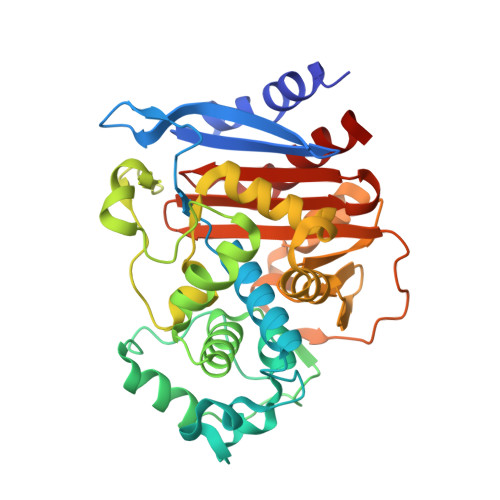1,2,3-Triazolylmethaneboronate: A Structure Activity Relationship Study of a Class of beta-Lactamase Inhibitors againstAcinetobacter baumanniiCephalosporinase.
Caselli, E., Fini, F., Introvigne, M.L., Stucchi, M., Taracila, M.A., Fish, E.R., Smolen, K.A., Rather, P.N., Powers, R.A., Wallar, B.J., Bonomo, R.A., Prati, F.(2020) ACS Infect Dis 6: 1965-1975
- PubMed: 32502340
- DOI: https://doi.org/10.1021/acsinfecdis.0c00254
- Primary Citation of Related Structures:
6TZF, 6TZG, 6TZH, 6TZI, 6TZJ - PubMed Abstract:
Boronic acid transition state inhibitors (BATSIs) are known reversible covalent inhibitors of serine β-lactamases. The selectivity and high potency of specific BATSIs bearing an amide side chain mimicking the β-lactam's amide side chain are an established and recognized synthetic strategy. Herein, we describe a new class of BATSIs where the amide group is replaced by a bioisostere triazole; these compounds were designed as molecular probes. To this end, a library of 26 α-triazolylmethaneboronic acids was synthesized and tested against the clinically concerning Acinetobacter -derived cephalosporinase, ADC-7. In steady state analyses, these compounds demonstrated K i values ranging from 90 nM to 38 μM (±10%). Five compounds were crystallized in complex with ADC-7 β-lactamase, and all the crystal structures reveal the triazole is in the putative amide binding site, thus confirming the triazole-amide bioisosterism. The easy synthetic access of these new inhibitors as prototype scaffolds allows the insertion of a wide range of chemical groups able to explore the enzyme binding site and provides insights on the importance of specific residues in recognition and catalysis. The best inhibitor identified, compound 6q ( K i 90 nM), places a tolyl group near Arg340, making favorable cation-π interactions. Notably, the structure of 6q does not resemble the natural substrate of the β-lactamase yet displays a pronounced inhibition activity, in addition to lowering the minimum inhibitory concentration (MIC) of ceftazidime against three bacterial strains expressing class C β-lactamases. In summary, these observations validate the α-triazolylboronic acids as a promising template for further inhibitor design.
Organizational Affiliation:
Department of Life Sciences, University of Modena and Reggio Emilia, via Campi 103, Modena 41125, Italy.
















